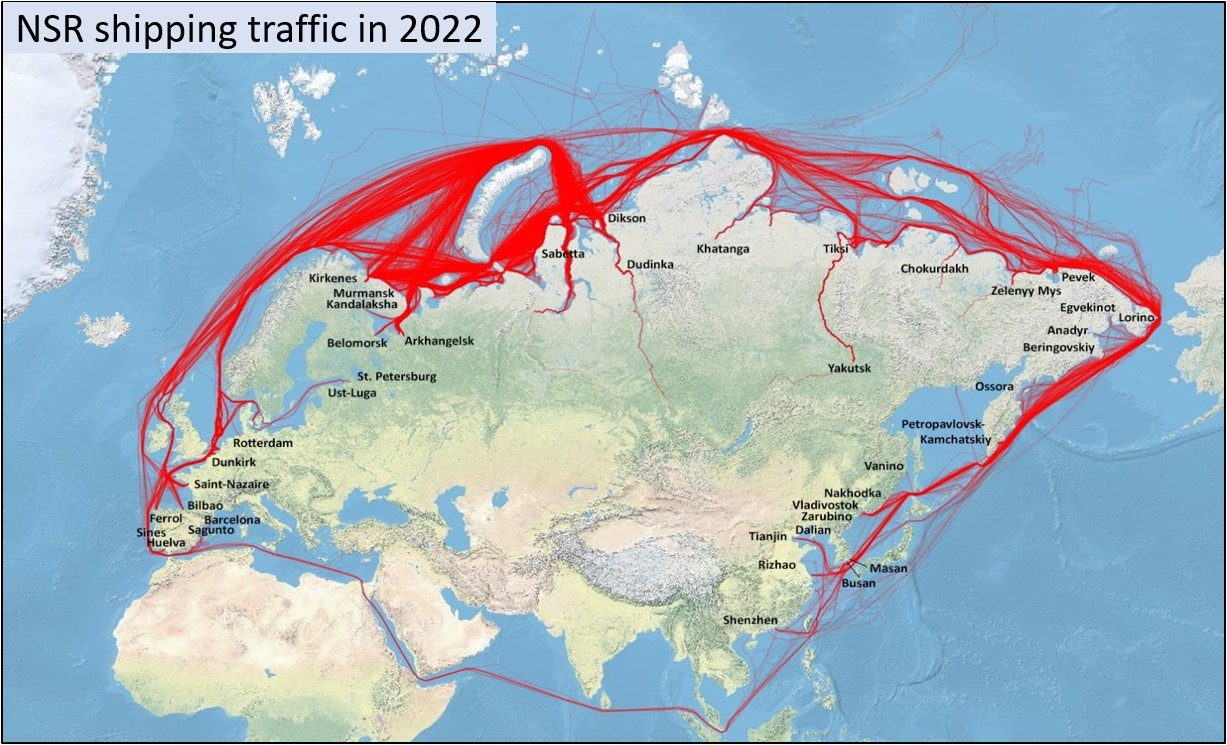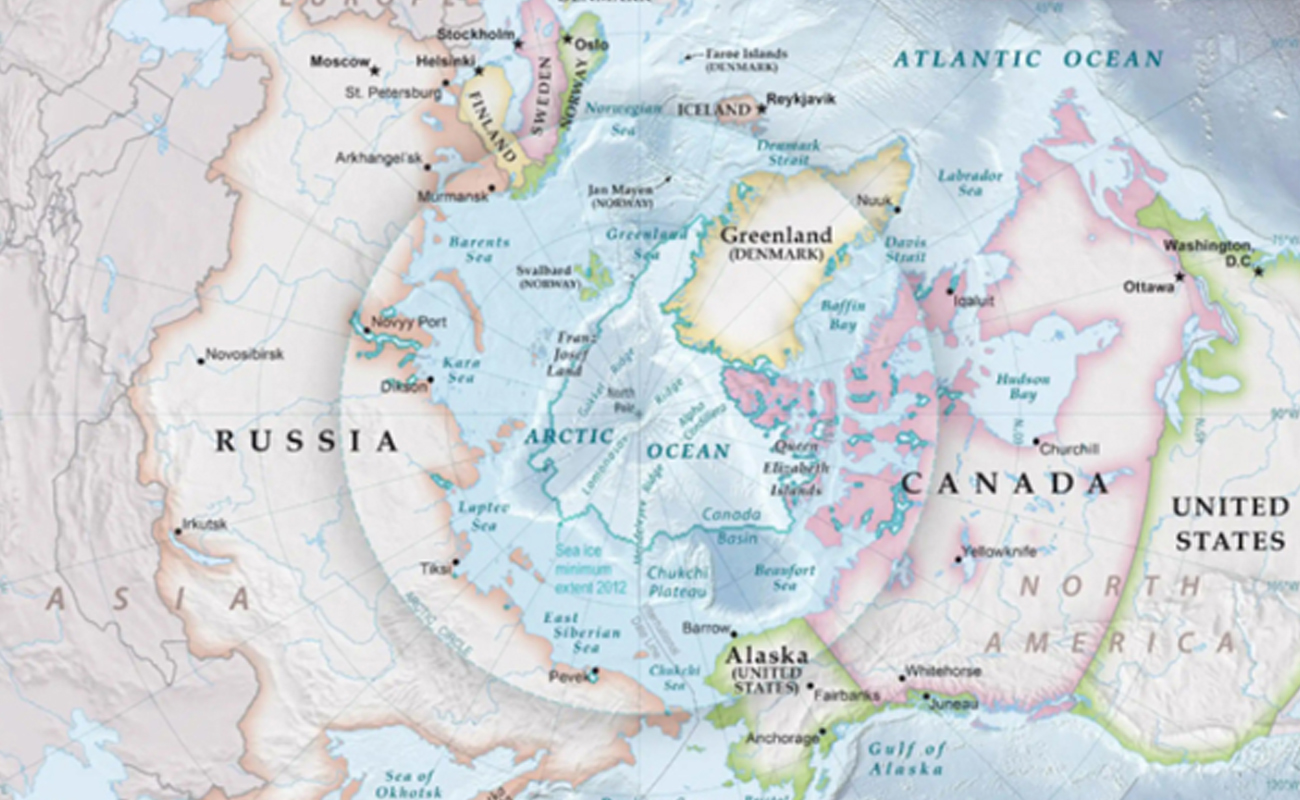Arctic Circle: A Geopolitical Hotspot
A map highlights the Arctic Circle – Source DOD
By Elham Kabir
Preface
The Arctic Circle, the northernmost latitude on Earth, has long held strategic and geopolitical importance. Historically, it was a key battleground during the Cold War, with the U.S. and Soviet Union establishing military presences there. Today, the melting of sea ice, driven by climate change, has made the Arctic a hotspot for new opportunities in resource extraction and maritime trade. Shipping routes like the Northern Sea Route and Northwest Passage now offer faster alternatives to traditional routes, but navigating these waters presents challenges due to harsh weather and limited infrastructure.
While the Arctic’s vast reserves of oil, gas, and critical minerals offer economic potential, they also raise concerns over geopolitical tensions and environmental harm. Countries with geographic proximity, such as Russia and Canada, stand to benefit most from these developments, with Russia playing a dominant role. China, despite having no Arctic coast, is pursuing a "Polar Silk Road" through strategic investments. The Arctic's transformation into a trade hub has the potential to disrupt global trading patterns and reshape economic alliances, marking a new chapter in international relations.
The Future of Trade in the Arctic
The Arctic region is undergoing a dramatic metamorphosis due to climate change, with the accelerated recession of sea ice opening novel maritime routes and access to abundant natural resources. This transformation is poised to exert a profound influence upon global trade patterns in the decades to come.
|
Route |
Distance (km) |
|
Suez Canal |
20,000 |
|
Northern Sea Route |
8,900 |
|
Distance Savings |
55% |
Table 1: Comparison of Shipping Distances
The Northern Sea Route (NSR), a pivotal Arctic shipping passage, provides a substantially shorter transit time between Europe and Asia in comparison to the conventional routes through the Suez or Panama Canals. As illustrated in Table 1 above, the NSR can reduce shipping distances by up to 55 percent, translating into substantial cost savings for shipping enterprises in terms of fuel consumption and transit time.

Figure 1: Map of the Northern Sea Route – Source MOL
The receding Arctic Sea ice has already precipitated a significant surge in shipping activity along the NSR. As depicted in Figure 1, the number of voyages on the NSR has escalated from a mere handful in the early 2000s to over 70 in 2020.

Figure 2: Number of Voyages along the Northern Sea Route
This trend is anticipated to persist, with some prognostications suggesting that up to 5 percent of global trade could be transported through the Arctic by 2050. However, the future of Arctic shipping hinges on climate change, infrastructure, and geopolitical factors. While offering potential benefits, it also raises environmental concerns. The region's development could significantly impact global trade patterns, shifting trade flows, creating new hubs, and providing access to resources. However, careful consideration of environmental impacts is crucial for sustainable growth.
Opportunities and Challenges in the Arctic
The Arctic region is undergoing significant transformations due to the impacts of climate change and globalization. These changes present both opportunities and challenges that require a cohesive and collaborative approach to Arctic governance.
Opportunities
The melting of Arctic Sea ice has opened access to potential oil, gas, and mineral resources in the region. Estimates suggest the Arctic holds a whopping 90 billion barrels of oil and 1,669 trillion cubic feet of natural gas, accounting for 22 percent of the world's oil and natural gas reserves. This discovery has sparked intense interest and competition among Arctic and non-Arctic states, all vying to tap into these valuable resources.
Furthermore, the shrinking sea ice has paved the way for new maritime routes, like the Northeast Passage along the Norwegian and Russian Arctic. This route is a whopping 37 percent shorter than the traditional Suez Canal route, offering exciting possibilities for increased international shipping and trade.
The increased access to resources and shipping routes can aid the economic development of indigenous communities in the Arctic, who have traditionally been highly dependent on the Arctic ecosystem.
Challenges
The increased human activity in the Arctic, such as resource extraction and shipping, poses a serious threat to the fragile Arctic ecosystem. This includes the potential for oil spills, environmental disasters, and the disruption of delicate Arctic wildlife and habitats.
Moreover, the influx of commercial activities and development in the Arctic threatens the traditional lifestyles and cultures of indigenous communities, who have lived in harmony with the Arctic environment for centuries.
Also, the growing economic importance of the Arctic has fueled geopolitical tensions among Arctic and non-Arctic states. Issues like territorial disputes, military deployments, and disagreements over maritime passages could threaten peace and stability in the region.
Additionally, the existing Arctic governance frameworks, like the Arctic Council and the United Nations Convention on the Law of the Sea (UNCLOS), are fragmented and lack the authority to effectively tackle the region's multifaceted challenges. A more unified and integrated approach to Arctic governance is necessary.
Potential Beneficiaries and the Changing Global Trading System in the Arctic
The Arctic's transformation due to climate change is poised to significantly reshape the global trading system. With the opening of new shipping routes and increased access to resources, several nations and regions stand to benefit, while others may face challenges.
Key Potential Beneficiaries
Arctic States: Countries with Arctic coastlines, including Russia, Canada, the United States, Norway, Sweden, Finland, Denmark (Greenland), and Iceland, are the most direct beneficiaries. They possess territorial claims, natural resources, and strategic advantages in the region.
Asian Countries: Nations like China, Japan, and South Korea are keen to capitalize on the Arctic's potential. Shorter shipping routes through the Arctic could significantly reduce transit times and costs for trade with Europe.
European Countries: European nations, particularly those in the Nordic region, are also interested in the Arctic's development. Increased trade with Asia and access to Arctic resources could bolster their economies.
Changing Global Trading System
The Arctic's development has the potential to disrupt established global trade patterns and supply chains. Some of the key changes include:
New Shipping Routes: NSR along Russia's northern coast and the Northwest Passage through Canada are becoming more navigable. These shorter routes could divert trade away from traditional routes like the Suez Canal and Panama Canal.
|
Route |
Distance (km) |
Travel Time (days) |
|
Northern Sea Route |
7,900 |
15 |
|
Suez Canal Route |
11,200 |
24 |
|
Panama Canal Route |
14,500 |
28 |
Table 2: Comparison of Shipping Distances and Travel Times

Figure 3: map showing the Northern Sea Route and the Northwest Passage – Source GRIDA
Increased Competition:
The competition for Arctic resources and trade routes could intensify geopolitical tensions and lead to new alliances and rivalries.

Figure 4: pie chart showing the estimated distribution of Arctic oil and gas reserves – Source: NAUTILUS
Shift in Economic Power:
The Arctic's development could shift the balance of economic power away from traditional maritime nations and towards Arctic states.

Figure 5: map showing Arctic territorial claims and areas of potential conflict – source: CIMSEC
Environmental Risks:
he increased human activity in the Arctic, such as shipping and resource extraction, poses significant environmental risks that could disrupt global supply chains.

Figure 6: world map with highlighted Arctic shipping routes and projected trade flows– source: NSIDC
Conclusion
The Arctic is undergoing rapid and unprecedented change, with the melting of sea ice and snow opening new areas for shipping, resource extraction, and tourism. This increased accessibility brings both opportunities and risks for the region. There is potential for economic benefits from oil, gas, and mineral development, as well as increased shipping and tourism. However, these activities also come with environmental risks, such as the threat of oil spills which could be devastating for Arctic ecosystems and communities that rely on hunting and fishing. Responding to and managing this change has become a key focus for the region, requiring improved scientific understanding, international cooperation, and involvement of local Arctic residents as research partners.
In-terms of future research indication and gaps, Key emerging research questions include as the Arctic rapidly changes, we need to understand how it will affect local communities, ecosystems, and wildlife. We also need to know more about the risks of increased coastal activity and the strategies needed to protect vulnerable communities. To address these challenges, we must work together across different fields of study and ensure sustainable development in the Arctic.
References:
Gross, Matthew. “Geopolitical Competition in the Arctic Circle.” Harvard International Review, December 2, 2020. https://hir.harvard.edu/the-arctic-circle/.
Analytics, FP. “Arctic Competition: Resource Competition in the Arctic.” Foreign Policy, October 13, 2020. https://foreignpolicy.com/2020/10/13/arctic-competition-resources-governance-critical-minerals-shipping-climate-change-power-map/.
Humpert, Malte. “The Future of the Northern Sea Route - a ‘Golden Waterway’ or a Niche Trade Route.” September 15, 2011. https://www.thearcticinstitute.org/future-northern-sea-route-golden-waterway-niche/.
Yumashev, D., van Hussen, K., Gille, J. et al. Towards a balanced view of Arctic shipping: estimating economic impacts of emissions from increased traffic on the Northern Sea Route. Climatic Change 143, 143–155 (2017). https://doi.org/10.1007/s10584-017-1980-
Long, Zhao. “Arctic Governance: Challenges and Opportunities.” Council on Foreign Relations, November 2018. https://www.cfr.org/report/arctic-governance.
Sheng, Edmund Li. “Arctic Opportunities and Challenges.” SpringerLink, 2022. https://link.springer.com/book/10.1007/978-981-19-1246-7.
The National Academies Press. “Read ‘the Arctic in the Anthropocene: Emerging Research Questions’ at Nap.Edu.”, 2014. https://nap.nationalacademies.org/read/18726/chapter/5.
Eva Gladek, et al. “The Global Food System: Trends, Impacts, and Solutions.” Metabolic, 2017. https://www.metabolic.nl/publication/global-food-system-an-analysis/.
The National Academies Press. “Arctic Matters: The Global Connection to Changes in the Arctic”, April 13, 2015. https://nap.nationalacademies.org/catalog/21717/arctic-matters-the-global-connection-to-changes-in-the-arctic.
Elham Kabir has a master’s degree in international relations. He has extensive professional experience of over 10 years, both in governmental and non-governmental entities, and in executive positions in Afghanistan.
Academicians and Officials interested to publish their academic pieces on this page, please approach us through: contact@aissonline.org.
The article does not reflect the official opinion of the AISS

